Total Reward Systems: Effectiveness in Tesco and British Airways
VerifiedAdded on 2020/06/04
|11
|3696
|179
Essay
AI Summary
This essay provides a comprehensive overview of total reward systems, exploring their significance in employee motivation and organizational performance. It defines total reward systems as encompassing all aspects of employee compensation, benefits, and development, both monetary and non-monetary. The essay examines the implementation of total reward systems at Tesco and British Airways, comparing their strategies and techniques. It delves into various motivation theories, including Maslow's hierarchy of needs and Herzberg's two-factor theory, to explain employee behavior and needs. The essay further discusses the benefits of total reward systems, such as increased employee engagement, improved retention, and enhanced organizational reputation. It highlights the importance of aligning reward strategies with business objectives and employee needs to create a positive and productive work environment. The essay also touches on the role of managers in fostering employee motivation through effective reward plans and open communication, emphasizing the significance of both intrinsic and extrinsic motivation factors.
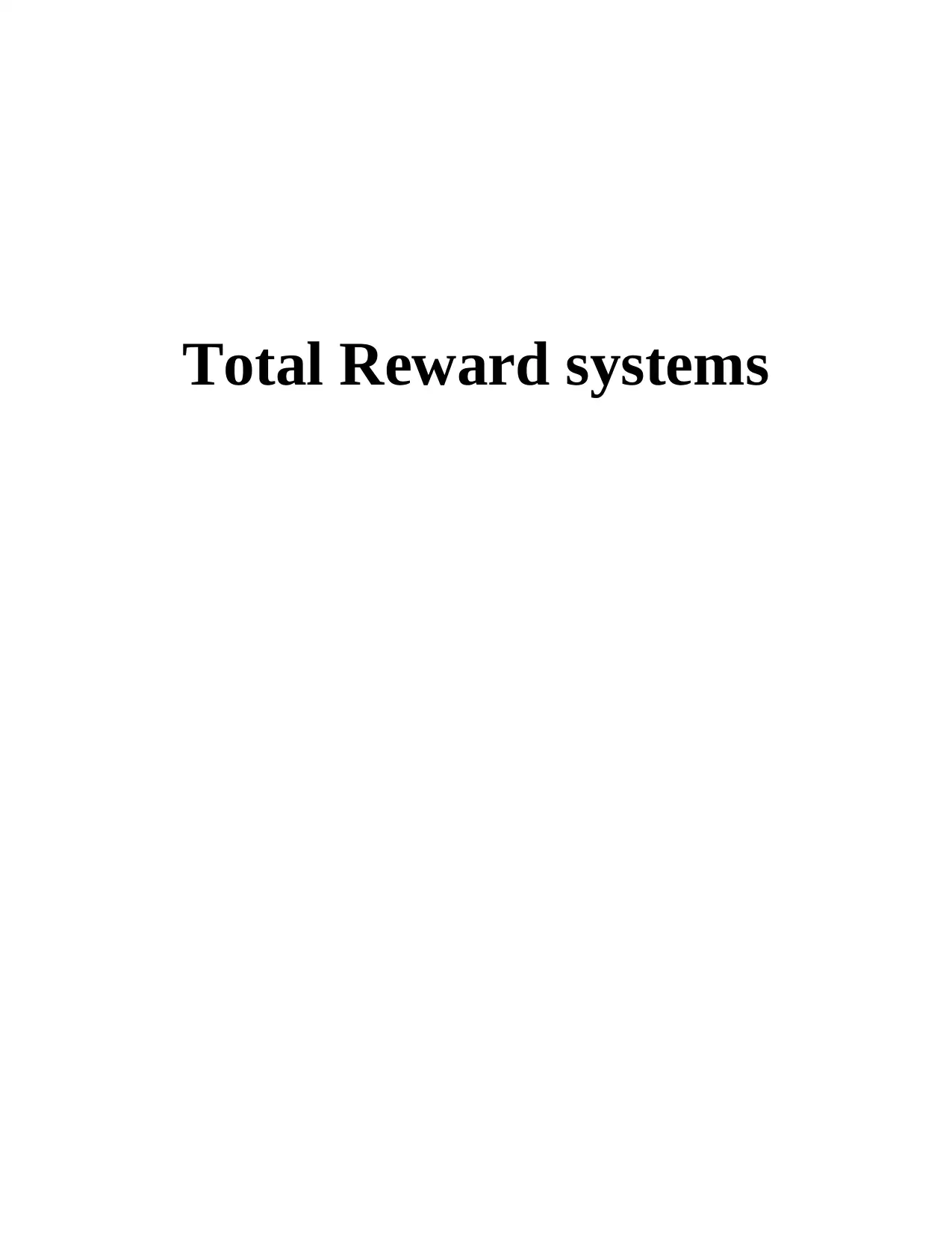
Total Reward systems
Paraphrase This Document
Need a fresh take? Get an instant paraphrase of this document with our AI Paraphraser
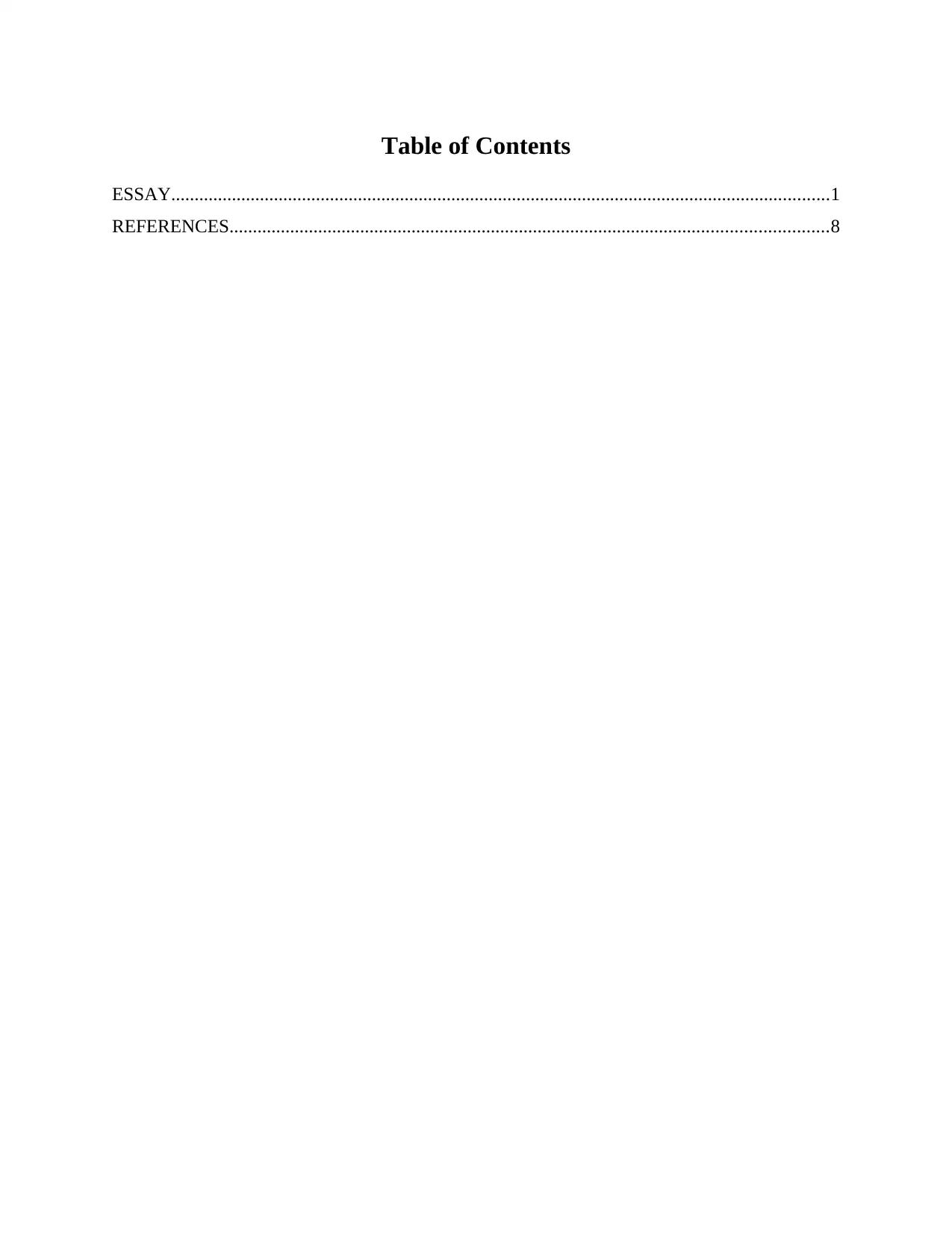
Table of Contents
ESSAY.............................................................................................................................................1
REFERENCES................................................................................................................................8
ESSAY.............................................................................................................................................1
REFERENCES................................................................................................................................8
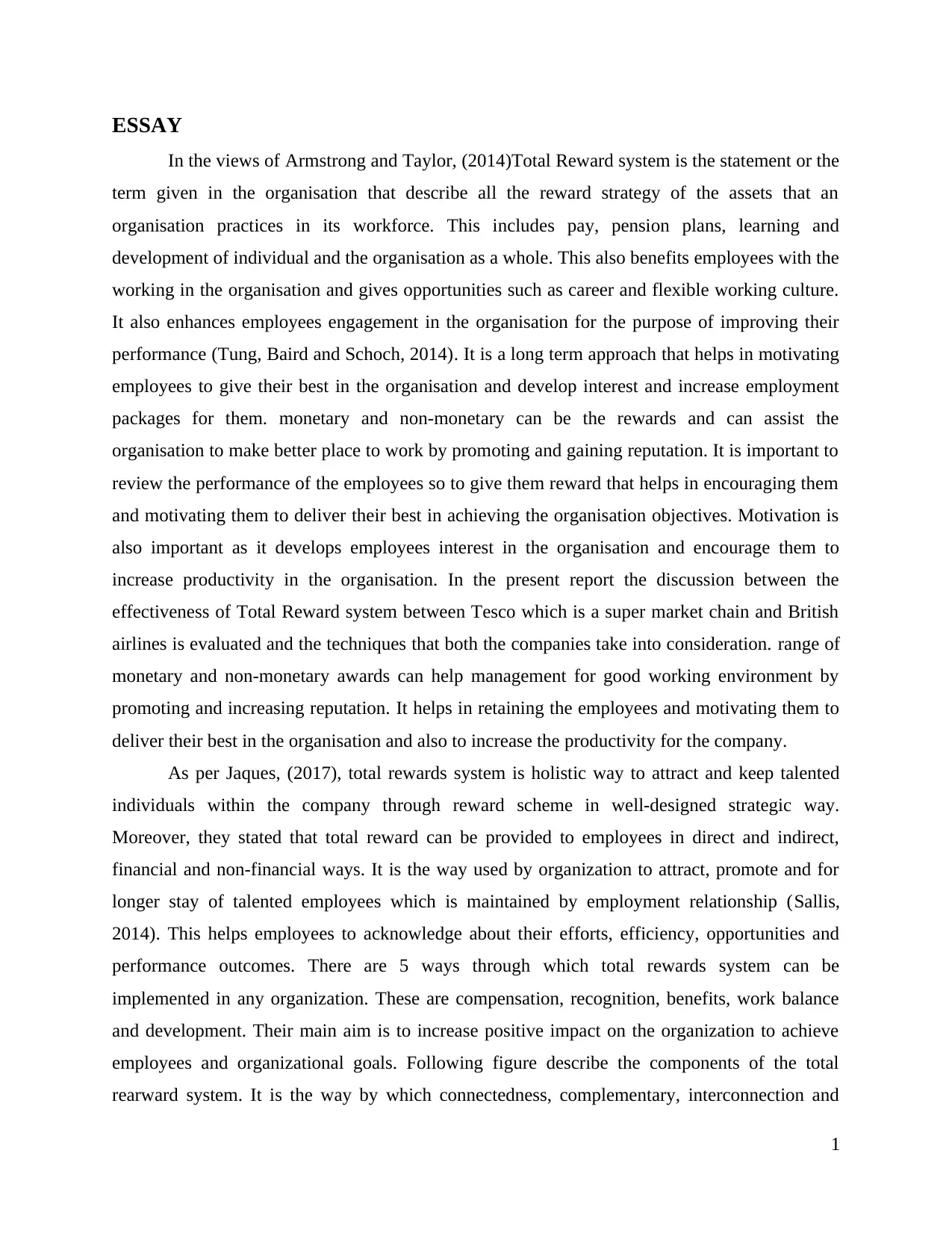
ESSAY
In the views of Armstrong and Taylor, (2014)Total Reward system is the statement or the
term given in the organisation that describe all the reward strategy of the assets that an
organisation practices in its workforce. This includes pay, pension plans, learning and
development of individual and the organisation as a whole. This also benefits employees with the
working in the organisation and gives opportunities such as career and flexible working culture.
It also enhances employees engagement in the organisation for the purpose of improving their
performance (Tung, Baird and Schoch, 2014). It is a long term approach that helps in motivating
employees to give their best in the organisation and develop interest and increase employment
packages for them. monetary and non-monetary can be the rewards and can assist the
organisation to make better place to work by promoting and gaining reputation. It is important to
review the performance of the employees so to give them reward that helps in encouraging them
and motivating them to deliver their best in achieving the organisation objectives. Motivation is
also important as it develops employees interest in the organisation and encourage them to
increase productivity in the organisation. In the present report the discussion between the
effectiveness of Total Reward system between Tesco which is a super market chain and British
airlines is evaluated and the techniques that both the companies take into consideration. range of
monetary and non-monetary awards can help management for good working environment by
promoting and increasing reputation. It helps in retaining the employees and motivating them to
deliver their best in the organisation and also to increase the productivity for the company.
As per Jaques, (2017), total rewards system is holistic way to attract and keep talented
individuals within the company through reward scheme in well-designed strategic way.
Moreover, they stated that total reward can be provided to employees in direct and indirect,
financial and non-financial ways. It is the way used by organization to attract, promote and for
longer stay of talented employees which is maintained by employment relationship (Sallis,
2014). This helps employees to acknowledge about their efforts, efficiency, opportunities and
performance outcomes. There are 5 ways through which total rewards system can be
implemented in any organization. These are compensation, recognition, benefits, work balance
and development. Their main aim is to increase positive impact on the organization to achieve
employees and organizational goals. Following figure describe the components of the total
rearward system. It is the way by which connectedness, complementary, interconnection and
1
In the views of Armstrong and Taylor, (2014)Total Reward system is the statement or the
term given in the organisation that describe all the reward strategy of the assets that an
organisation practices in its workforce. This includes pay, pension plans, learning and
development of individual and the organisation as a whole. This also benefits employees with the
working in the organisation and gives opportunities such as career and flexible working culture.
It also enhances employees engagement in the organisation for the purpose of improving their
performance (Tung, Baird and Schoch, 2014). It is a long term approach that helps in motivating
employees to give their best in the organisation and develop interest and increase employment
packages for them. monetary and non-monetary can be the rewards and can assist the
organisation to make better place to work by promoting and gaining reputation. It is important to
review the performance of the employees so to give them reward that helps in encouraging them
and motivating them to deliver their best in achieving the organisation objectives. Motivation is
also important as it develops employees interest in the organisation and encourage them to
increase productivity in the organisation. In the present report the discussion between the
effectiveness of Total Reward system between Tesco which is a super market chain and British
airlines is evaluated and the techniques that both the companies take into consideration. range of
monetary and non-monetary awards can help management for good working environment by
promoting and increasing reputation. It helps in retaining the employees and motivating them to
deliver their best in the organisation and also to increase the productivity for the company.
As per Jaques, (2017), total rewards system is holistic way to attract and keep talented
individuals within the company through reward scheme in well-designed strategic way.
Moreover, they stated that total reward can be provided to employees in direct and indirect,
financial and non-financial ways. It is the way used by organization to attract, promote and for
longer stay of talented employees which is maintained by employment relationship (Sallis,
2014). This helps employees to acknowledge about their efforts, efficiency, opportunities and
performance outcomes. There are 5 ways through which total rewards system can be
implemented in any organization. These are compensation, recognition, benefits, work balance
and development. Their main aim is to increase positive impact on the organization to achieve
employees and organizational goals. Following figure describe the components of the total
rearward system. It is the way by which connectedness, complementary, interconnection and
1
⊘ This is a preview!⊘
Do you want full access?
Subscribe today to unlock all pages.

Trusted by 1+ million students worldwide
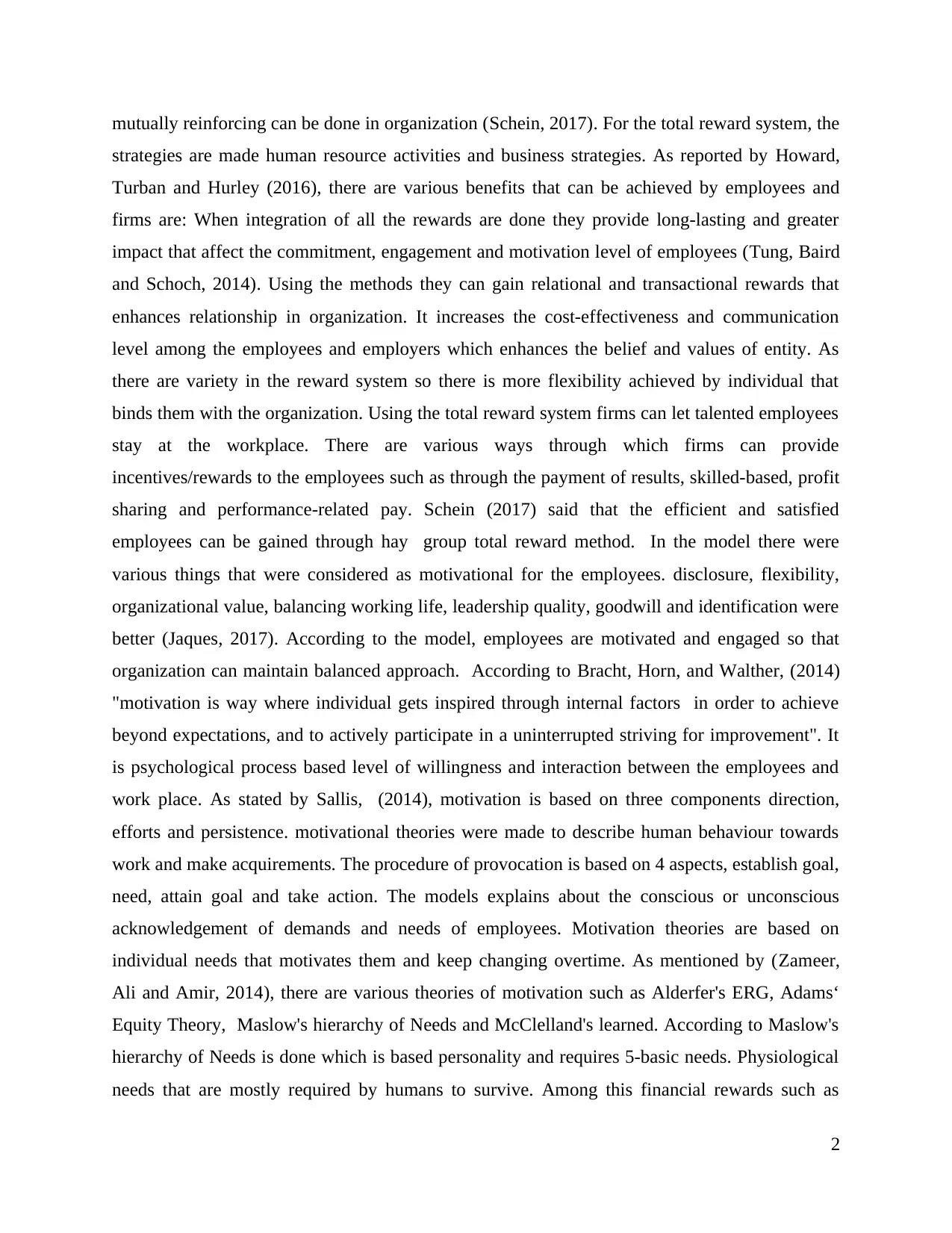
mutually reinforcing can be done in organization (Schein, 2017). For the total reward system, the
strategies are made human resource activities and business strategies. As reported by Howard,
Turban and Hurley (2016), there are various benefits that can be achieved by employees and
firms are: When integration of all the rewards are done they provide long-lasting and greater
impact that affect the commitment, engagement and motivation level of employees (Tung, Baird
and Schoch, 2014). Using the methods they can gain relational and transactional rewards that
enhances relationship in organization. It increases the cost-effectiveness and communication
level among the employees and employers which enhances the belief and values of entity. As
there are variety in the reward system so there is more flexibility achieved by individual that
binds them with the organization. Using the total reward system firms can let talented employees
stay at the workplace. There are various ways through which firms can provide
incentives/rewards to the employees such as through the payment of results, skilled-based, profit
sharing and performance-related pay. Schein (2017) said that the efficient and satisfied
employees can be gained through hay group total reward method. In the model there were
various things that were considered as motivational for the employees. disclosure, flexibility,
organizational value, balancing working life, leadership quality, goodwill and identification were
better (Jaques, 2017). According to the model, employees are motivated and engaged so that
organization can maintain balanced approach. According to Bracht, Horn, and Walther, (2014)
"motivation is way where individual gets inspired through internal factors in order to achieve
beyond expectations, and to actively participate in a uninterrupted striving for improvement". It
is psychological process based level of willingness and interaction between the employees and
work place. As stated by Sallis, (2014), motivation is based on three components direction,
efforts and persistence. motivational theories were made to describe human behaviour towards
work and make acquirements. The procedure of provocation is based on 4 aspects, establish goal,
need, attain goal and take action. The models explains about the conscious or unconscious
acknowledgement of demands and needs of employees. Motivation theories are based on
individual needs that motivates them and keep changing overtime. As mentioned by (Zameer,
Ali and Amir, 2014), there are various theories of motivation such as Alderfer's ERG, Adams‘
Equity Theory, Maslow's hierarchy of Needs and McClelland's learned. According to Maslow's
hierarchy of Needs is done which is based personality and requires 5-basic needs. Physiological
needs that are mostly required by humans to survive. Among this financial rewards such as
2
strategies are made human resource activities and business strategies. As reported by Howard,
Turban and Hurley (2016), there are various benefits that can be achieved by employees and
firms are: When integration of all the rewards are done they provide long-lasting and greater
impact that affect the commitment, engagement and motivation level of employees (Tung, Baird
and Schoch, 2014). Using the methods they can gain relational and transactional rewards that
enhances relationship in organization. It increases the cost-effectiveness and communication
level among the employees and employers which enhances the belief and values of entity. As
there are variety in the reward system so there is more flexibility achieved by individual that
binds them with the organization. Using the total reward system firms can let talented employees
stay at the workplace. There are various ways through which firms can provide
incentives/rewards to the employees such as through the payment of results, skilled-based, profit
sharing and performance-related pay. Schein (2017) said that the efficient and satisfied
employees can be gained through hay group total reward method. In the model there were
various things that were considered as motivational for the employees. disclosure, flexibility,
organizational value, balancing working life, leadership quality, goodwill and identification were
better (Jaques, 2017). According to the model, employees are motivated and engaged so that
organization can maintain balanced approach. According to Bracht, Horn, and Walther, (2014)
"motivation is way where individual gets inspired through internal factors in order to achieve
beyond expectations, and to actively participate in a uninterrupted striving for improvement". It
is psychological process based level of willingness and interaction between the employees and
work place. As stated by Sallis, (2014), motivation is based on three components direction,
efforts and persistence. motivational theories were made to describe human behaviour towards
work and make acquirements. The procedure of provocation is based on 4 aspects, establish goal,
need, attain goal and take action. The models explains about the conscious or unconscious
acknowledgement of demands and needs of employees. Motivation theories are based on
individual needs that motivates them and keep changing overtime. As mentioned by (Zameer,
Ali and Amir, 2014), there are various theories of motivation such as Alderfer's ERG, Adams‘
Equity Theory, Maslow's hierarchy of Needs and McClelland's learned. According to Maslow's
hierarchy of Needs is done which is based personality and requires 5-basic needs. Physiological
needs that are mostly required by humans to survive. Among this financial rewards such as
2
Paraphrase This Document
Need a fresh take? Get an instant paraphrase of this document with our AI Paraphraser
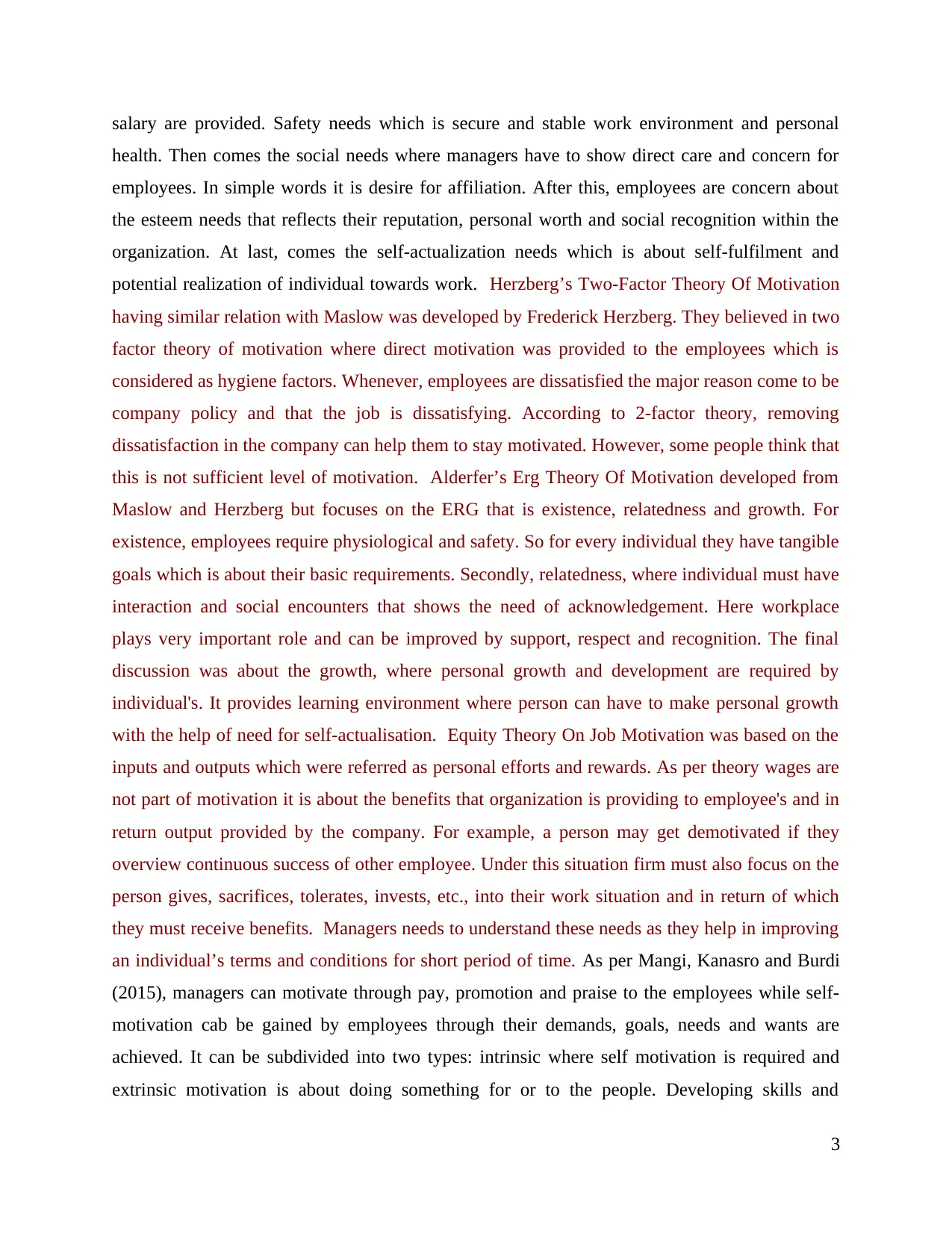
salary are provided. Safety needs which is secure and stable work environment and personal
health. Then comes the social needs where managers have to show direct care and concern for
employees. In simple words it is desire for affiliation. After this, employees are concern about
the esteem needs that reflects their reputation, personal worth and social recognition within the
organization. At last, comes the self-actualization needs which is about self-fulfilment and
potential realization of individual towards work. Herzberg’s Two-Factor Theory Of Motivation
having similar relation with Maslow was developed by Frederick Herzberg. They believed in two
factor theory of motivation where direct motivation was provided to the employees which is
considered as hygiene factors. Whenever, employees are dissatisfied the major reason come to be
company policy and that the job is dissatisfying. According to 2-factor theory, removing
dissatisfaction in the company can help them to stay motivated. However, some people think that
this is not sufficient level of motivation. Alderfer’s Erg Theory Of Motivation developed from
Maslow and Herzberg but focuses on the ERG that is existence, relatedness and growth. For
existence, employees require physiological and safety. So for every individual they have tangible
goals which is about their basic requirements. Secondly, relatedness, where individual must have
interaction and social encounters that shows the need of acknowledgement. Here workplace
plays very important role and can be improved by support, respect and recognition. The final
discussion was about the growth, where personal growth and development are required by
individual's. It provides learning environment where person can have to make personal growth
with the help of need for self-actualisation. Equity Theory On Job Motivation was based on the
inputs and outputs which were referred as personal efforts and rewards. As per theory wages are
not part of motivation it is about the benefits that organization is providing to employee's and in
return output provided by the company. For example, a person may get demotivated if they
overview continuous success of other employee. Under this situation firm must also focus on the
person gives, sacrifices, tolerates, invests, etc., into their work situation and in return of which
they must receive benefits. Managers needs to understand these needs as they help in improving
an individual’s terms and conditions for short period of time. As per Mangi, Kanasro and Burdi
(2015), managers can motivate through pay, promotion and praise to the employees while self-
motivation cab be gained by employees through their demands, goals, needs and wants are
achieved. It can be subdivided into two types: intrinsic where self motivation is required and
extrinsic motivation is about doing something for or to the people. Developing skills and
3
health. Then comes the social needs where managers have to show direct care and concern for
employees. In simple words it is desire for affiliation. After this, employees are concern about
the esteem needs that reflects their reputation, personal worth and social recognition within the
organization. At last, comes the self-actualization needs which is about self-fulfilment and
potential realization of individual towards work. Herzberg’s Two-Factor Theory Of Motivation
having similar relation with Maslow was developed by Frederick Herzberg. They believed in two
factor theory of motivation where direct motivation was provided to the employees which is
considered as hygiene factors. Whenever, employees are dissatisfied the major reason come to be
company policy and that the job is dissatisfying. According to 2-factor theory, removing
dissatisfaction in the company can help them to stay motivated. However, some people think that
this is not sufficient level of motivation. Alderfer’s Erg Theory Of Motivation developed from
Maslow and Herzberg but focuses on the ERG that is existence, relatedness and growth. For
existence, employees require physiological and safety. So for every individual they have tangible
goals which is about their basic requirements. Secondly, relatedness, where individual must have
interaction and social encounters that shows the need of acknowledgement. Here workplace
plays very important role and can be improved by support, respect and recognition. The final
discussion was about the growth, where personal growth and development are required by
individual's. It provides learning environment where person can have to make personal growth
with the help of need for self-actualisation. Equity Theory On Job Motivation was based on the
inputs and outputs which were referred as personal efforts and rewards. As per theory wages are
not part of motivation it is about the benefits that organization is providing to employee's and in
return output provided by the company. For example, a person may get demotivated if they
overview continuous success of other employee. Under this situation firm must also focus on the
person gives, sacrifices, tolerates, invests, etc., into their work situation and in return of which
they must receive benefits. Managers needs to understand these needs as they help in improving
an individual’s terms and conditions for short period of time. As per Mangi, Kanasro and Burdi
(2015), managers can motivate through pay, promotion and praise to the employees while self-
motivation cab be gained by employees through their demands, goals, needs and wants are
achieved. It can be subdivided into two types: intrinsic where self motivation is required and
extrinsic motivation is about doing something for or to the people. Developing skills and
3
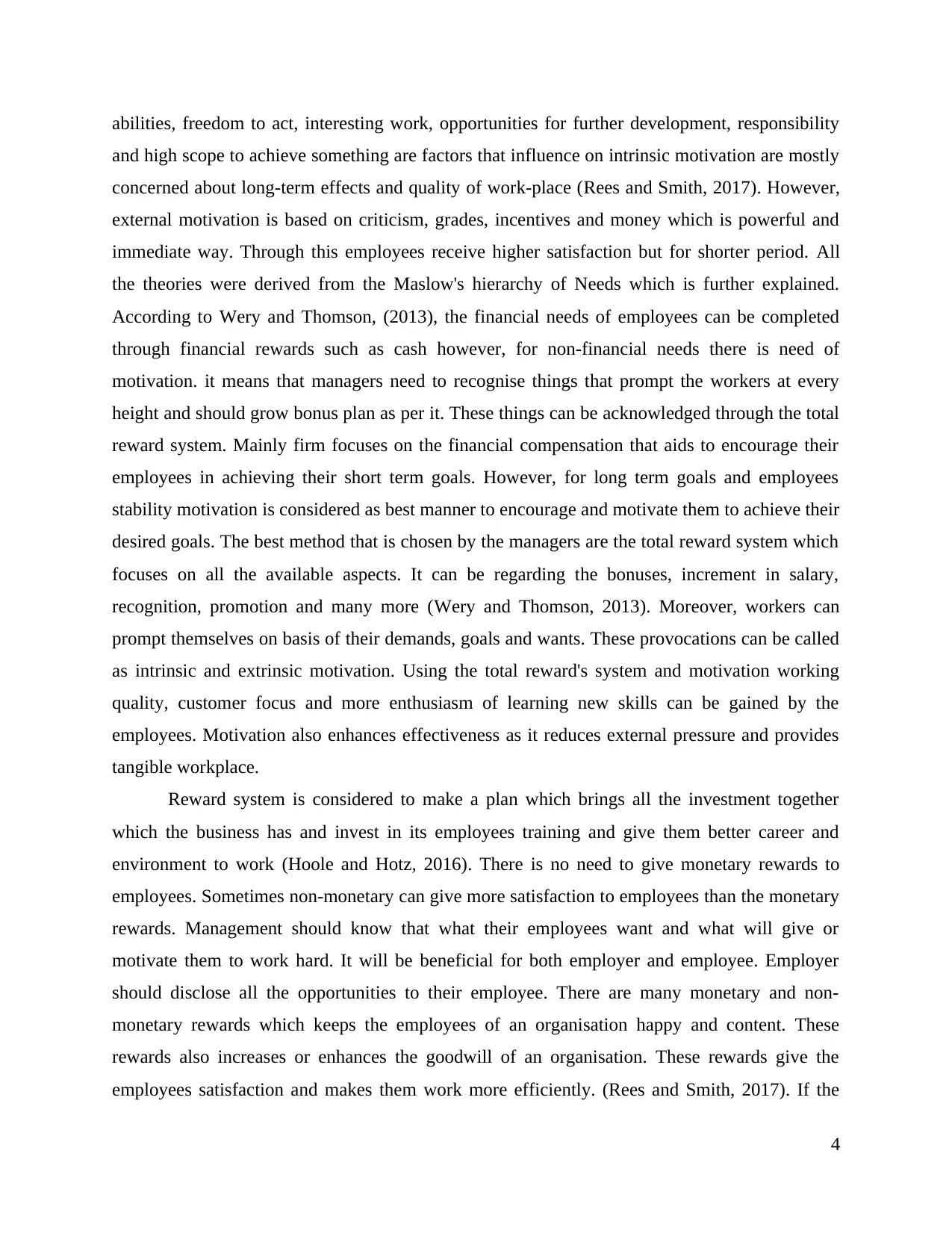
abilities, freedom to act, interesting work, opportunities for further development, responsibility
and high scope to achieve something are factors that influence on intrinsic motivation are mostly
concerned about long-term effects and quality of work-place (Rees and Smith, 2017). However,
external motivation is based on criticism, grades, incentives and money which is powerful and
immediate way. Through this employees receive higher satisfaction but for shorter period. All
the theories were derived from the Maslow's hierarchy of Needs which is further explained.
According to Wery and Thomson, (2013), the financial needs of employees can be completed
through financial rewards such as cash however, for non-financial needs there is need of
motivation. it means that managers need to recognise things that prompt the workers at every
height and should grow bonus plan as per it. These things can be acknowledged through the total
reward system. Mainly firm focuses on the financial compensation that aids to encourage their
employees in achieving their short term goals. However, for long term goals and employees
stability motivation is considered as best manner to encourage and motivate them to achieve their
desired goals. The best method that is chosen by the managers are the total reward system which
focuses on all the available aspects. It can be regarding the bonuses, increment in salary,
recognition, promotion and many more (Wery and Thomson, 2013). Moreover, workers can
prompt themselves on basis of their demands, goals and wants. These provocations can be called
as intrinsic and extrinsic motivation. Using the total reward's system and motivation working
quality, customer focus and more enthusiasm of learning new skills can be gained by the
employees. Motivation also enhances effectiveness as it reduces external pressure and provides
tangible workplace.
Reward system is considered to make a plan which brings all the investment together
which the business has and invest in its employees training and give them better career and
environment to work (Hoole and Hotz, 2016). There is no need to give monetary rewards to
employees. Sometimes non-monetary can give more satisfaction to employees than the monetary
rewards. Management should know that what their employees want and what will give or
motivate them to work hard. It will be beneficial for both employer and employee. Employer
should disclose all the opportunities to their employee. There are many monetary and non-
monetary rewards which keeps the employees of an organisation happy and content. These
rewards also increases or enhances the goodwill of an organisation. These rewards give the
employees satisfaction and makes them work more efficiently. (Rees and Smith, 2017). If the
4
and high scope to achieve something are factors that influence on intrinsic motivation are mostly
concerned about long-term effects and quality of work-place (Rees and Smith, 2017). However,
external motivation is based on criticism, grades, incentives and money which is powerful and
immediate way. Through this employees receive higher satisfaction but for shorter period. All
the theories were derived from the Maslow's hierarchy of Needs which is further explained.
According to Wery and Thomson, (2013), the financial needs of employees can be completed
through financial rewards such as cash however, for non-financial needs there is need of
motivation. it means that managers need to recognise things that prompt the workers at every
height and should grow bonus plan as per it. These things can be acknowledged through the total
reward system. Mainly firm focuses on the financial compensation that aids to encourage their
employees in achieving their short term goals. However, for long term goals and employees
stability motivation is considered as best manner to encourage and motivate them to achieve their
desired goals. The best method that is chosen by the managers are the total reward system which
focuses on all the available aspects. It can be regarding the bonuses, increment in salary,
recognition, promotion and many more (Wery and Thomson, 2013). Moreover, workers can
prompt themselves on basis of their demands, goals and wants. These provocations can be called
as intrinsic and extrinsic motivation. Using the total reward's system and motivation working
quality, customer focus and more enthusiasm of learning new skills can be gained by the
employees. Motivation also enhances effectiveness as it reduces external pressure and provides
tangible workplace.
Reward system is considered to make a plan which brings all the investment together
which the business has and invest in its employees training and give them better career and
environment to work (Hoole and Hotz, 2016). There is no need to give monetary rewards to
employees. Sometimes non-monetary can give more satisfaction to employees than the monetary
rewards. Management should know that what their employees want and what will give or
motivate them to work hard. It will be beneficial for both employer and employee. Employer
should disclose all the opportunities to their employee. There are many monetary and non-
monetary rewards which keeps the employees of an organisation happy and content. These
rewards also increases or enhances the goodwill of an organisation. These rewards give the
employees satisfaction and makes them work more efficiently. (Rees and Smith, 2017). If the
4
⊘ This is a preview!⊘
Do you want full access?
Subscribe today to unlock all pages.

Trusted by 1+ million students worldwide
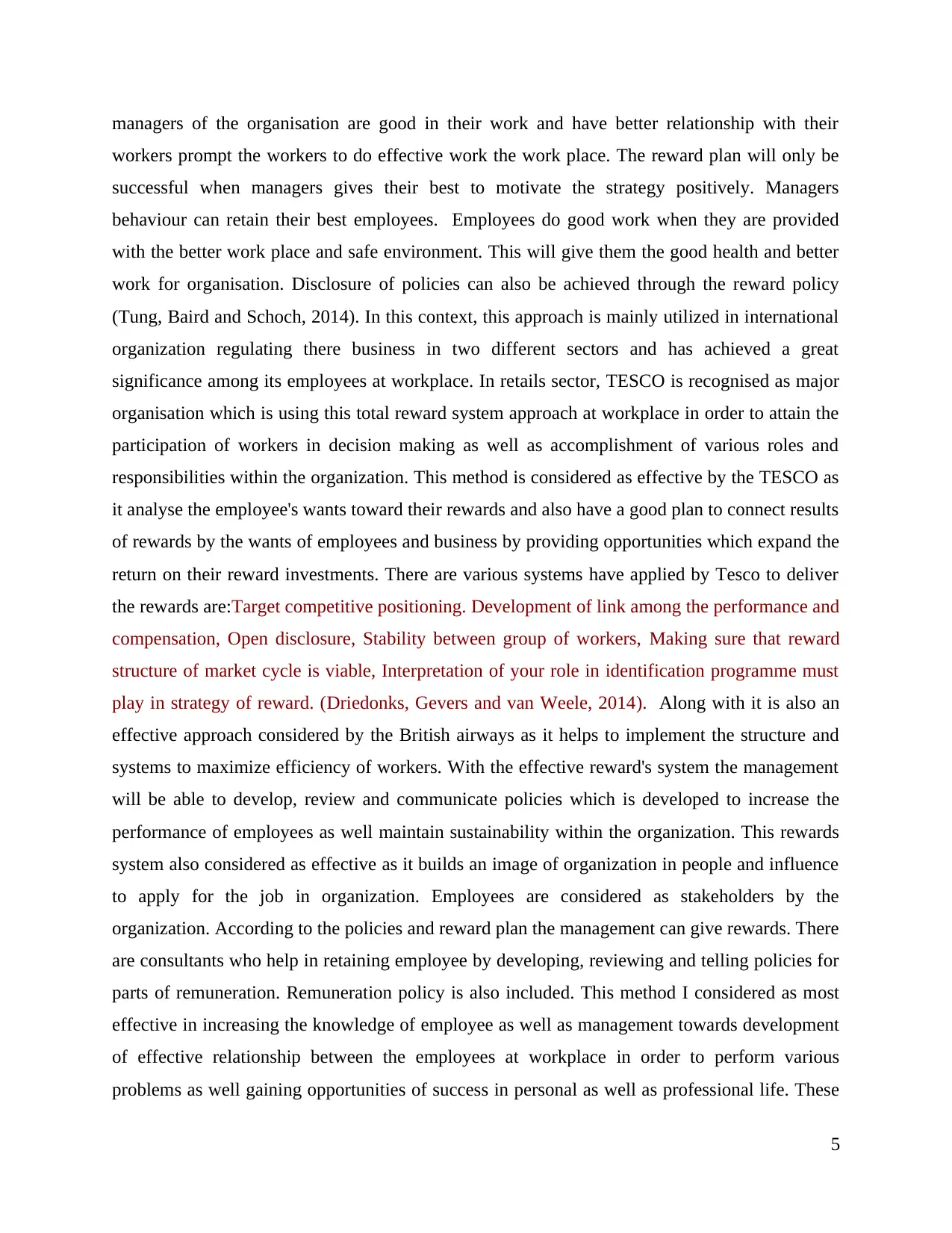
managers of the organisation are good in their work and have better relationship with their
workers prompt the workers to do effective work the work place. The reward plan will only be
successful when managers gives their best to motivate the strategy positively. Managers
behaviour can retain their best employees. Employees do good work when they are provided
with the better work place and safe environment. This will give them the good health and better
work for organisation. Disclosure of policies can also be achieved through the reward policy
(Tung, Baird and Schoch, 2014). In this context, this approach is mainly utilized in international
organization regulating there business in two different sectors and has achieved a great
significance among its employees at workplace. In retails sector, TESCO is recognised as major
organisation which is using this total reward system approach at workplace in order to attain the
participation of workers in decision making as well as accomplishment of various roles and
responsibilities within the organization. This method is considered as effective by the TESCO as
it analyse the employee's wants toward their rewards and also have a good plan to connect results
of rewards by the wants of employees and business by providing opportunities which expand the
return on their reward investments. There are various systems have applied by Tesco to deliver
the rewards are:Target competitive positioning. Development of link among the performance and
compensation, Open disclosure, Stability between group of workers, Making sure that reward
structure of market cycle is viable, Interpretation of your role in identification programme must
play in strategy of reward. (Driedonks, Gevers and van Weele, 2014). Along with it is also an
effective approach considered by the British airways as it helps to implement the structure and
systems to maximize efficiency of workers. With the effective reward's system the management
will be able to develop, review and communicate policies which is developed to increase the
performance of employees as well maintain sustainability within the organization. This rewards
system also considered as effective as it builds an image of organization in people and influence
to apply for the job in organization. Employees are considered as stakeholders by the
organization. According to the policies and reward plan the management can give rewards. There
are consultants who help in retaining employee by developing, reviewing and telling policies for
parts of remuneration. Remuneration policy is also included. This method I considered as most
effective in increasing the knowledge of employee as well as management towards development
of effective relationship between the employees at workplace in order to perform various
problems as well gaining opportunities of success in personal as well as professional life. These
5
workers prompt the workers to do effective work the work place. The reward plan will only be
successful when managers gives their best to motivate the strategy positively. Managers
behaviour can retain their best employees. Employees do good work when they are provided
with the better work place and safe environment. This will give them the good health and better
work for organisation. Disclosure of policies can also be achieved through the reward policy
(Tung, Baird and Schoch, 2014). In this context, this approach is mainly utilized in international
organization regulating there business in two different sectors and has achieved a great
significance among its employees at workplace. In retails sector, TESCO is recognised as major
organisation which is using this total reward system approach at workplace in order to attain the
participation of workers in decision making as well as accomplishment of various roles and
responsibilities within the organization. This method is considered as effective by the TESCO as
it analyse the employee's wants toward their rewards and also have a good plan to connect results
of rewards by the wants of employees and business by providing opportunities which expand the
return on their reward investments. There are various systems have applied by Tesco to deliver
the rewards are:Target competitive positioning. Development of link among the performance and
compensation, Open disclosure, Stability between group of workers, Making sure that reward
structure of market cycle is viable, Interpretation of your role in identification programme must
play in strategy of reward. (Driedonks, Gevers and van Weele, 2014). Along with it is also an
effective approach considered by the British airways as it helps to implement the structure and
systems to maximize efficiency of workers. With the effective reward's system the management
will be able to develop, review and communicate policies which is developed to increase the
performance of employees as well maintain sustainability within the organization. This rewards
system also considered as effective as it builds an image of organization in people and influence
to apply for the job in organization. Employees are considered as stakeholders by the
organization. According to the policies and reward plan the management can give rewards. There
are consultants who help in retaining employee by developing, reviewing and telling policies for
parts of remuneration. Remuneration policy is also included. This method I considered as most
effective in increasing the knowledge of employee as well as management towards development
of effective relationship between the employees at workplace in order to perform various
problems as well gaining opportunities of success in personal as well as professional life. These
5
Paraphrase This Document
Need a fresh take? Get an instant paraphrase of this document with our AI Paraphraser
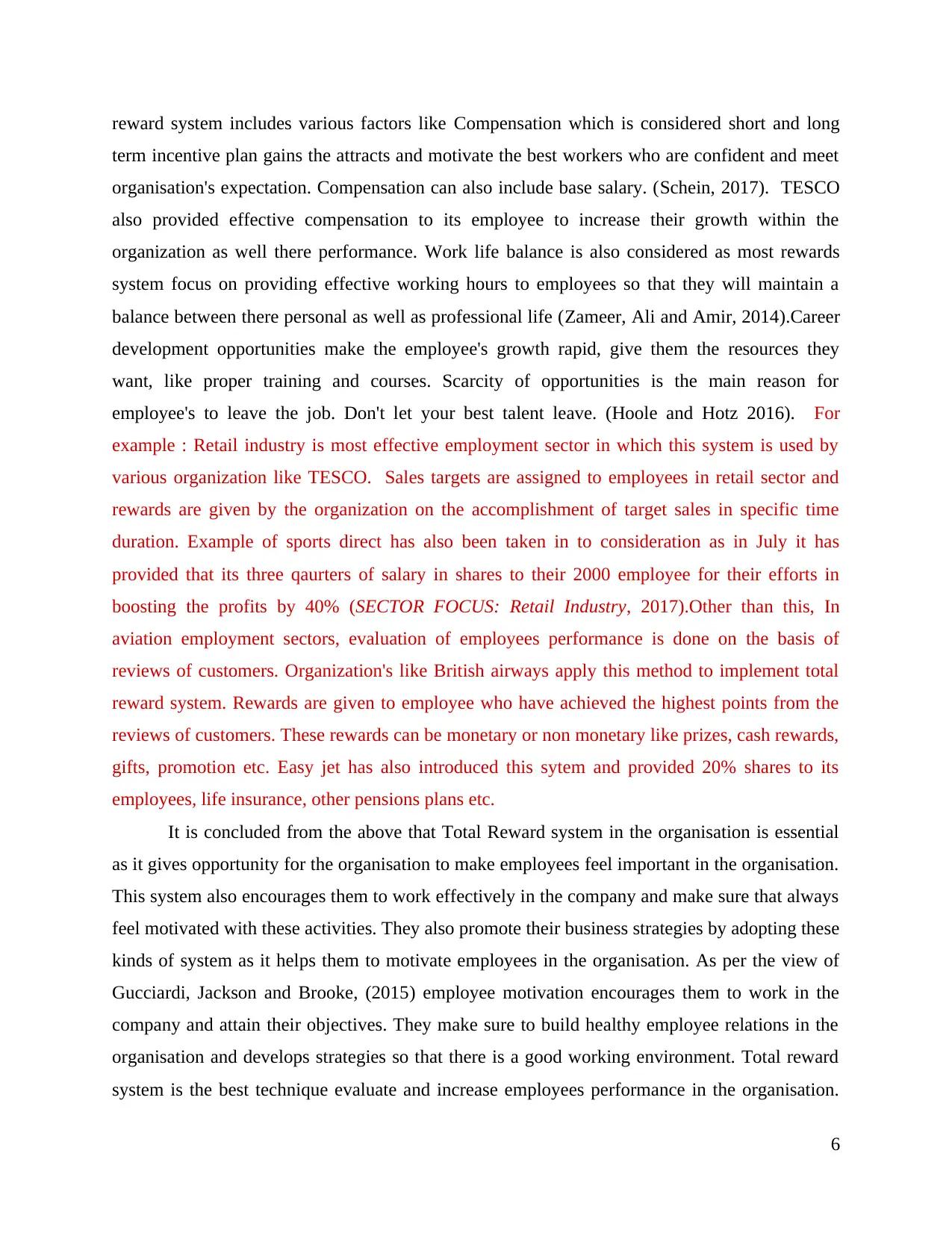
reward system includes various factors like Compensation which is considered short and long
term incentive plan gains the attracts and motivate the best workers who are confident and meet
organisation's expectation. Compensation can also include base salary. (Schein, 2017). TESCO
also provided effective compensation to its employee to increase their growth within the
organization as well there performance. Work life balance is also considered as most rewards
system focus on providing effective working hours to employees so that they will maintain a
balance between there personal as well as professional life (Zameer, Ali and Amir, 2014).Career
development opportunities make the employee's growth rapid, give them the resources they
want, like proper training and courses. Scarcity of opportunities is the main reason for
employee's to leave the job. Don't let your best talent leave. (Hoole and Hotz 2016). For
example : Retail industry is most effective employment sector in which this system is used by
various organization like TESCO. Sales targets are assigned to employees in retail sector and
rewards are given by the organization on the accomplishment of target sales in specific time
duration. Example of sports direct has also been taken in to consideration as in July it has
provided that its three qaurters of salary in shares to their 2000 employee for their efforts in
boosting the profits by 40% (SECTOR FOCUS: Retail Industry, 2017).Other than this, In
aviation employment sectors, evaluation of employees performance is done on the basis of
reviews of customers. Organization's like British airways apply this method to implement total
reward system. Rewards are given to employee who have achieved the highest points from the
reviews of customers. These rewards can be monetary or non monetary like prizes, cash rewards,
gifts, promotion etc. Easy jet has also introduced this sytem and provided 20% shares to its
employees, life insurance, other pensions plans etc.
It is concluded from the above that Total Reward system in the organisation is essential
as it gives opportunity for the organisation to make employees feel important in the organisation.
This system also encourages them to work effectively in the company and make sure that always
feel motivated with these activities. They also promote their business strategies by adopting these
kinds of system as it helps them to motivate employees in the organisation. As per the view of
Gucciardi, Jackson and Brooke, (2015) employee motivation encourages them to work in the
company and attain their objectives. They make sure to build healthy employee relations in the
organisation and develops strategies so that there is a good working environment. Total reward
system is the best technique evaluate and increase employees performance in the organisation.
6
term incentive plan gains the attracts and motivate the best workers who are confident and meet
organisation's expectation. Compensation can also include base salary. (Schein, 2017). TESCO
also provided effective compensation to its employee to increase their growth within the
organization as well there performance. Work life balance is also considered as most rewards
system focus on providing effective working hours to employees so that they will maintain a
balance between there personal as well as professional life (Zameer, Ali and Amir, 2014).Career
development opportunities make the employee's growth rapid, give them the resources they
want, like proper training and courses. Scarcity of opportunities is the main reason for
employee's to leave the job. Don't let your best talent leave. (Hoole and Hotz 2016). For
example : Retail industry is most effective employment sector in which this system is used by
various organization like TESCO. Sales targets are assigned to employees in retail sector and
rewards are given by the organization on the accomplishment of target sales in specific time
duration. Example of sports direct has also been taken in to consideration as in July it has
provided that its three qaurters of salary in shares to their 2000 employee for their efforts in
boosting the profits by 40% (SECTOR FOCUS: Retail Industry, 2017).Other than this, In
aviation employment sectors, evaluation of employees performance is done on the basis of
reviews of customers. Organization's like British airways apply this method to implement total
reward system. Rewards are given to employee who have achieved the highest points from the
reviews of customers. These rewards can be monetary or non monetary like prizes, cash rewards,
gifts, promotion etc. Easy jet has also introduced this sytem and provided 20% shares to its
employees, life insurance, other pensions plans etc.
It is concluded from the above that Total Reward system in the organisation is essential
as it gives opportunity for the organisation to make employees feel important in the organisation.
This system also encourages them to work effectively in the company and make sure that always
feel motivated with these activities. They also promote their business strategies by adopting these
kinds of system as it helps them to motivate employees in the organisation. As per the view of
Gucciardi, Jackson and Brooke, (2015) employee motivation encourages them to work in the
company and attain their objectives. They make sure to build healthy employee relations in the
organisation and develops strategies so that there is a good working environment. Total reward
system is the best technique evaluate and increase employees performance in the organisation.
6
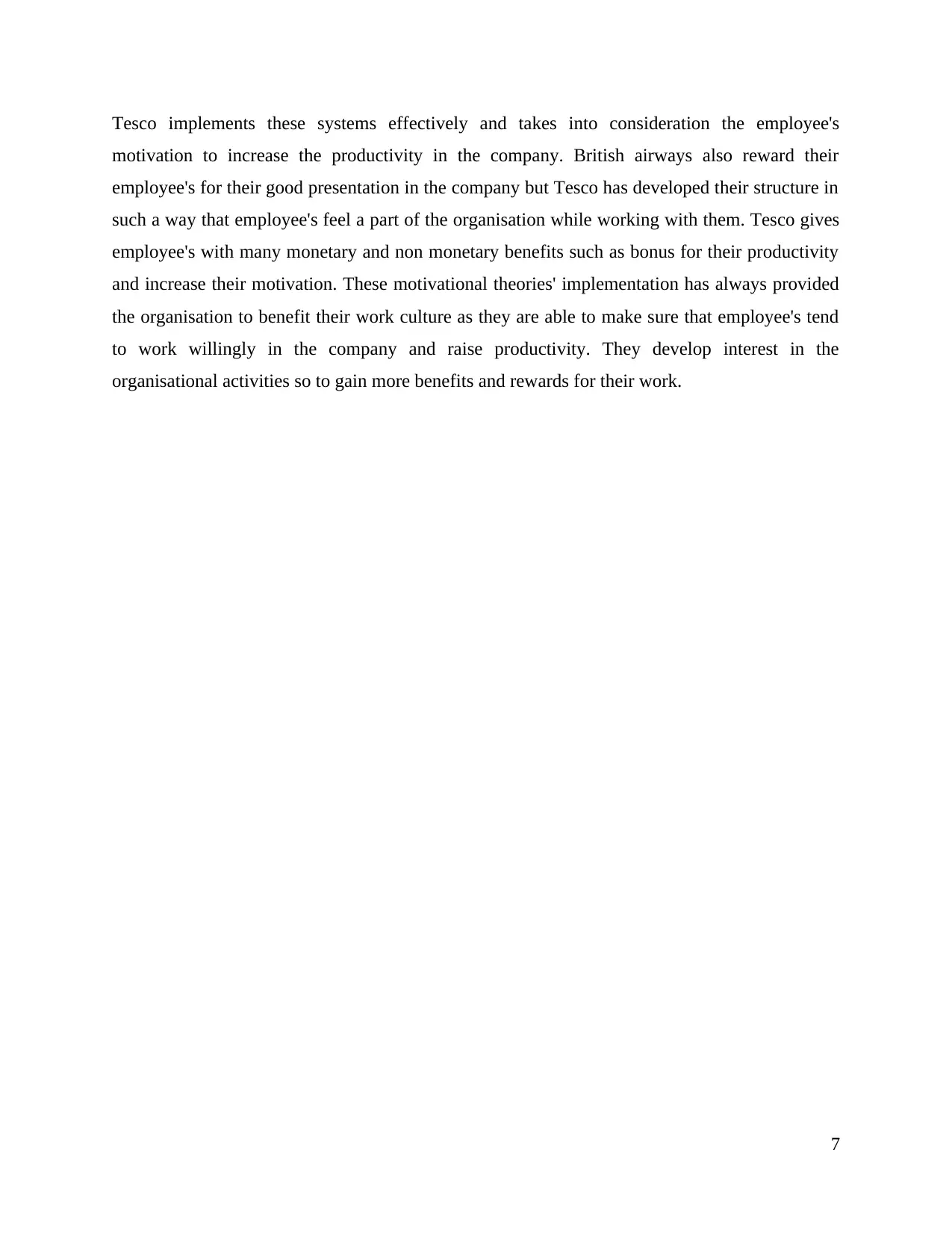
Tesco implements these systems effectively and takes into consideration the employee's
motivation to increase the productivity in the company. British airways also reward their
employee's for their good presentation in the company but Tesco has developed their structure in
such a way that employee's feel a part of the organisation while working with them. Tesco gives
employee's with many monetary and non monetary benefits such as bonus for their productivity
and increase their motivation. These motivational theories' implementation has always provided
the organisation to benefit their work culture as they are able to make sure that employee's tend
to work willingly in the company and raise productivity. They develop interest in the
organisational activities so to gain more benefits and rewards for their work.
7
motivation to increase the productivity in the company. British airways also reward their
employee's for their good presentation in the company but Tesco has developed their structure in
such a way that employee's feel a part of the organisation while working with them. Tesco gives
employee's with many monetary and non monetary benefits such as bonus for their productivity
and increase their motivation. These motivational theories' implementation has always provided
the organisation to benefit their work culture as they are able to make sure that employee's tend
to work willingly in the company and raise productivity. They develop interest in the
organisational activities so to gain more benefits and rewards for their work.
7
⊘ This is a preview!⊘
Do you want full access?
Subscribe today to unlock all pages.

Trusted by 1+ million students worldwide
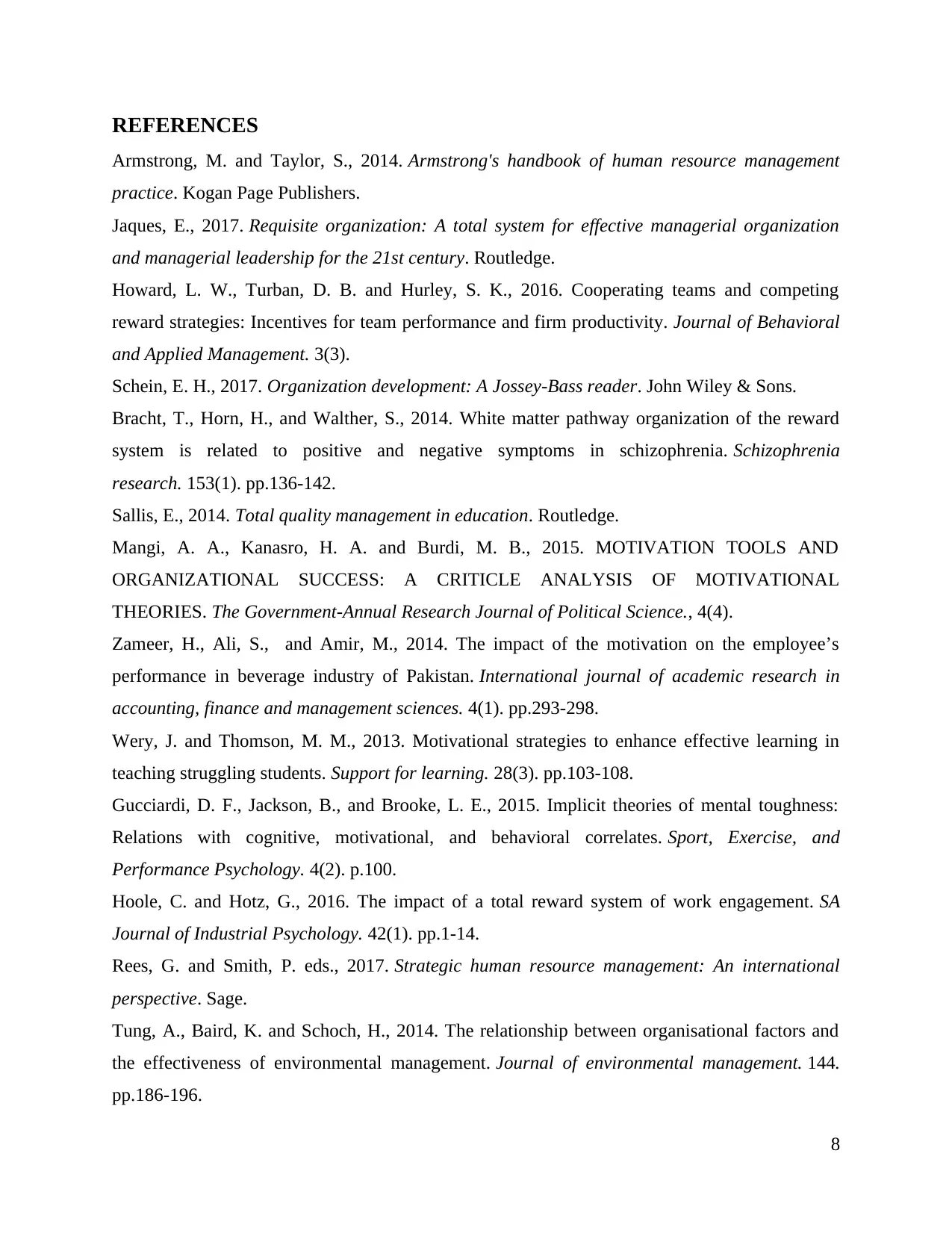
REFERENCES
Armstrong, M. and Taylor, S., 2014. Armstrong's handbook of human resource management
practice. Kogan Page Publishers.
Jaques, E., 2017. Requisite organization: A total system for effective managerial organization
and managerial leadership for the 21st century. Routledge.
Howard, L. W., Turban, D. B. and Hurley, S. K., 2016. Cooperating teams and competing
reward strategies: Incentives for team performance and firm productivity. Journal of Behavioral
and Applied Management. 3(3).
Schein, E. H., 2017. Organization development: A Jossey-Bass reader. John Wiley & Sons.
Bracht, T., Horn, H., and Walther, S., 2014. White matter pathway organization of the reward
system is related to positive and negative symptoms in schizophrenia. Schizophrenia
research. 153(1). pp.136-142.
Sallis, E., 2014. Total quality management in education. Routledge.
Mangi, A. A., Kanasro, H. A. and Burdi, M. B., 2015. MOTIVATION TOOLS AND
ORGANIZATIONAL SUCCESS: A CRITICLE ANALYSIS OF MOTIVATIONAL
THEORIES. The Government-Annual Research Journal of Political Science., 4(4).
Zameer, H., Ali, S., and Amir, M., 2014. The impact of the motivation on the employee’s
performance in beverage industry of Pakistan. International journal of academic research in
accounting, finance and management sciences. 4(1). pp.293-298.
Wery, J. and Thomson, M. M., 2013. Motivational strategies to enhance effective learning in
teaching struggling students. Support for learning. 28(3). pp.103-108.
Gucciardi, D. F., Jackson, B., and Brooke, L. E., 2015. Implicit theories of mental toughness:
Relations with cognitive, motivational, and behavioral correlates. Sport, Exercise, and
Performance Psychology. 4(2). p.100.
Hoole, C. and Hotz, G., 2016. The impact of a total reward system of work engagement. SA
Journal of Industrial Psychology. 42(1). pp.1-14.
Rees, G. and Smith, P. eds., 2017. Strategic human resource management: An international
perspective. Sage.
Tung, A., Baird, K. and Schoch, H., 2014. The relationship between organisational factors and
the effectiveness of environmental management. Journal of environmental management. 144.
pp.186-196.
8
Armstrong, M. and Taylor, S., 2014. Armstrong's handbook of human resource management
practice. Kogan Page Publishers.
Jaques, E., 2017. Requisite organization: A total system for effective managerial organization
and managerial leadership for the 21st century. Routledge.
Howard, L. W., Turban, D. B. and Hurley, S. K., 2016. Cooperating teams and competing
reward strategies: Incentives for team performance and firm productivity. Journal of Behavioral
and Applied Management. 3(3).
Schein, E. H., 2017. Organization development: A Jossey-Bass reader. John Wiley & Sons.
Bracht, T., Horn, H., and Walther, S., 2014. White matter pathway organization of the reward
system is related to positive and negative symptoms in schizophrenia. Schizophrenia
research. 153(1). pp.136-142.
Sallis, E., 2014. Total quality management in education. Routledge.
Mangi, A. A., Kanasro, H. A. and Burdi, M. B., 2015. MOTIVATION TOOLS AND
ORGANIZATIONAL SUCCESS: A CRITICLE ANALYSIS OF MOTIVATIONAL
THEORIES. The Government-Annual Research Journal of Political Science., 4(4).
Zameer, H., Ali, S., and Amir, M., 2014. The impact of the motivation on the employee’s
performance in beverage industry of Pakistan. International journal of academic research in
accounting, finance and management sciences. 4(1). pp.293-298.
Wery, J. and Thomson, M. M., 2013. Motivational strategies to enhance effective learning in
teaching struggling students. Support for learning. 28(3). pp.103-108.
Gucciardi, D. F., Jackson, B., and Brooke, L. E., 2015. Implicit theories of mental toughness:
Relations with cognitive, motivational, and behavioral correlates. Sport, Exercise, and
Performance Psychology. 4(2). p.100.
Hoole, C. and Hotz, G., 2016. The impact of a total reward system of work engagement. SA
Journal of Industrial Psychology. 42(1). pp.1-14.
Rees, G. and Smith, P. eds., 2017. Strategic human resource management: An international
perspective. Sage.
Tung, A., Baird, K. and Schoch, H., 2014. The relationship between organisational factors and
the effectiveness of environmental management. Journal of environmental management. 144.
pp.186-196.
8
Paraphrase This Document
Need a fresh take? Get an instant paraphrase of this document with our AI Paraphraser
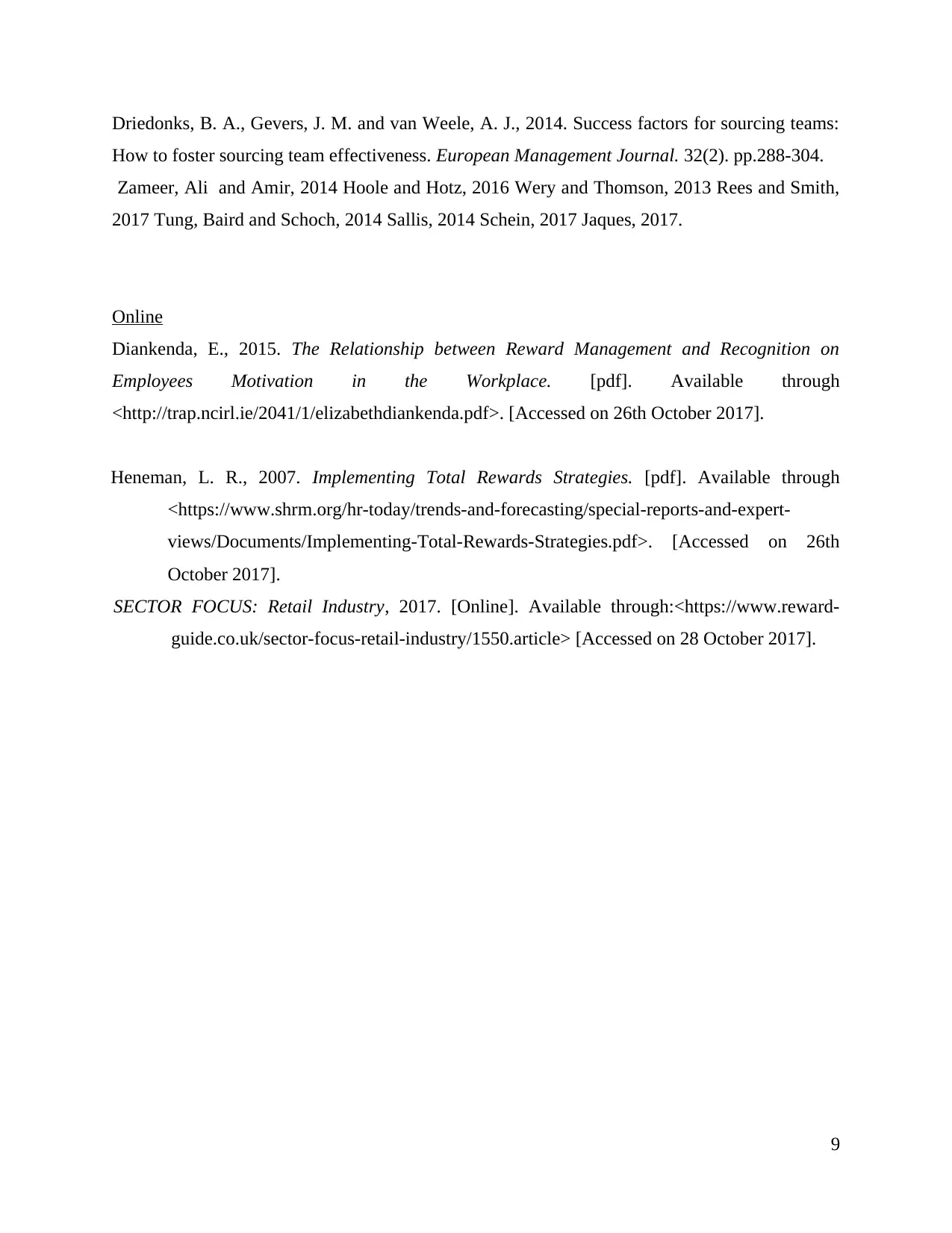
Driedonks, B. A., Gevers, J. M. and van Weele, A. J., 2014. Success factors for sourcing teams:
How to foster sourcing team effectiveness. European Management Journal. 32(2). pp.288-304.
Zameer, Ali and Amir, 2014 Hoole and Hotz, 2016 Wery and Thomson, 2013 Rees and Smith,
2017 Tung, Baird and Schoch, 2014 Sallis, 2014 Schein, 2017 Jaques, 2017.
Online
Diankenda, E., 2015. The Relationship between Reward Management and Recognition on
Employees Motivation in the Workplace. [pdf]. Available through
<http://trap.ncirl.ie/2041/1/elizabethdiankenda.pdf>. [Accessed on 26th October 2017].
Heneman, L. R., 2007. Implementing Total Rewards Strategies. [pdf]. Available through
<https://www.shrm.org/hr-today/trends-and-forecasting/special-reports-and-expert-
views/Documents/Implementing-Total-Rewards-Strategies.pdf>. [Accessed on 26th
October 2017].
SECTOR FOCUS: Retail Industry, 2017. [Online]. Available through:<https://www.reward-
guide.co.uk/sector-focus-retail-industry/1550.article> [Accessed on 28 October 2017].
9
How to foster sourcing team effectiveness. European Management Journal. 32(2). pp.288-304.
Zameer, Ali and Amir, 2014 Hoole and Hotz, 2016 Wery and Thomson, 2013 Rees and Smith,
2017 Tung, Baird and Schoch, 2014 Sallis, 2014 Schein, 2017 Jaques, 2017.
Online
Diankenda, E., 2015. The Relationship between Reward Management and Recognition on
Employees Motivation in the Workplace. [pdf]. Available through
<http://trap.ncirl.ie/2041/1/elizabethdiankenda.pdf>. [Accessed on 26th October 2017].
Heneman, L. R., 2007. Implementing Total Rewards Strategies. [pdf]. Available through
<https://www.shrm.org/hr-today/trends-and-forecasting/special-reports-and-expert-
views/Documents/Implementing-Total-Rewards-Strategies.pdf>. [Accessed on 26th
October 2017].
SECTOR FOCUS: Retail Industry, 2017. [Online]. Available through:<https://www.reward-
guide.co.uk/sector-focus-retail-industry/1550.article> [Accessed on 28 October 2017].
9
1 out of 11
Related Documents
Your All-in-One AI-Powered Toolkit for Academic Success.
+13062052269
info@desklib.com
Available 24*7 on WhatsApp / Email
![[object Object]](/_next/static/media/star-bottom.7253800d.svg)
Unlock your academic potential
Copyright © 2020–2025 A2Z Services. All Rights Reserved. Developed and managed by ZUCOL.





